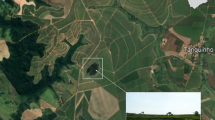Abstract
The Quaternary aquifer of Wadi Ham, UAE has been overexploited during the last two decades to meet the increasing water demands. As a result, the dynamic balance between freshwater and seawater has been disturbed and the quality of the groundwater has deteriorated. In this paper, a 2D earth resistivity survey was conducted in Wadi Ham in the area between Fujairah and Kalba to delineate the seawater intrusion. Existing monitoring wells were used to measure the horizontal and vertical variations in water salinity and thus to improve the interpretation of earth resistivity imaging data. Results of vertical electrical soundings and chemical analyses of collected water samples were used to obtain an empirical relationship between the inferred earth resistivity and the amount of total dissolved solids. This relationship was used along with the true resistivity sections resulting from the inversion of 2D resistivity data to identify three zones of water-bearing formation (fresh, brackish, and salt-water zones). Along the four 2D resistivity profiles, the depth to the fresh-brackish interface exceeded 50 m at the western part of the area and was in the order of 10 m or less in the eastern side near the shoreline. Depth to the brackish-saline water interface reached about 70 m in the western side and was in the order of 20 m in the eastern side. The thickness of the fresh water zone decreases considerably in the farming areas toward Kalba and thus the degree of seawater intrusion increases.


















Similar content being viewed by others
References
Cartwright K, McComas MR (1968) Geophysical surveys in the vicinity of sanitary landfills in northeastern Illinois. Ground Water 5:23–30
Cartwright K, Sherman F (1972) Electrical earth resistivity surveying in landfill investigations. 10th Annual Engineering and Soils Engineering Symposium, Moscow, ID
Cooper HH, Jacob CE (1946) A generalized graphical method for evaluating formation constants and summarizing well field history. T Am Geophys Un 27:526–534
deGroot-Hedlin C, Constable S (1990) Occam’s inversion to generate smooth, two-dimensional models from magnetotelluric data. Geophysics 55(12):1613–1624
Ebraheem AM, Hamburger M W, Bayless ER, Krothe NC (1990) A study of acid mine drainage using earth resistivity measurements. Ground Water 28(3):361–368
Ebraheem AM, Senosy MM, Dahab KA (1997) Geoelectrical and hydrogeochemical studies for delineating groundwater contamination due to salt-water intrusion in the northern part of the Nile Delta, Egypt. Ground Water 35(2):216–222
Edwards LS (1977) A modified pseudosection for resistivity and IP. Geophysics 42(5):1020–1036
Electrowatt E. (1981) Wadi Bih dam and Groundwater recharge facilities. Internal Report: Vol. 1: Design, Ministry of Agriculture and Fisheries, Dubai, UAE
EL-Mahmoudi AS (1999) Geoelectric Resistivity Investigations of Kafr Saqr Sheet, Sharrqiya Governorate, East Nile Delta. J Petrol Min Eng 2(1):84–108
Fetter CW (2001) Applied Hydrogeology,4th edn. Prentice Hall Inc., New Jersey, p 598
Freeze AR, Cherry JA (1979) Groundwater. Prentice Hall Inc., New Jersey
Haeni FP, Placzek, Gary, Trent RE (1992) Use of ground-penetrating radar to investigate infilled scour holes at bridge foundations. In: Hanninen, Pauli and Autio, Sini (eds) Fourth International Conference on Ground Penetrating Radar, Rovaniemi, Finland, June 8–13, 1992, Proceedings: Geological Survey of Finland Special Paper 16, p. 285–292
IWACO (1986) Groundwater Study Project 21/81, Drilling of deep water wells at various locations in the UAE. Groundwater Development in the Northern Agricultural Region. Internal Report (vol. 7), Ministry of Agriculture and Fisheries, Dubai, UAE
Loke MH (1997) Electrical imaging surveys for environmental and engineering studies–a practical guide to 2D and 3D surveys: Penang, Malaysia, University Sains Malaysia, unpublished short training course lecture notes
Mussett AE, Khan MA (2000). Looking into the Earth: An Introduction to Geological Geophysics. Cambridge University Press, p 492
Reynolds JM (1997) An introduction to applied and environmental geophysics. Wiley, New York, p 796
Sasaki Y (1992) Resolution of resistivity tomography inferred from numerical simulation. Geophys Prospect 40:453–464
Sharma PV (1997) Environmental and engineering geophysics. Cambridge University Press
Sherif M et al (2004) Assessment of the Effectiveness of Al Bih, Al Tawiyean and Ham Dams in Groundwater Recharge using Numerical Models, Interim Report. Ministry of Agricultural and Fisheries, Dubai, UAE
Stiff HA (1951) The interpretation of chemical water analysis by means of patterns. J Petrol Technol 3:15–17
Theis CV (1935) The realation between the lowering of the piezometric surface and the rate and uration of discharge of a well using groundwater storage. T Am Geophys Un 2:519–524
Todd DK (1980) Groundwater hydrology, 2nd edn. Wiley, New York, p 535
Acknowledgements
This study was funded by the joint United Arab Emirates University — Sultan Qaboos University collaboration research project (no. 01/7/60/2003). The help and support of the Ministry of Agriculture and Fisheries, Dubai, and Sharjah Electricity and Water Authority, UAE to complete the field activities are highly appreciated. We would also like to thank Prof. Dr. Sigrid Dörhöfer, Editor and anonymous reviewer of Environmental Geology Journal for their valuable comments
Author information
Authors and Affiliations
Corresponding author
Rights and permissions
About this article
Cite this article
Sherif, M., Mahmoudi, A.E., Garamoon, H. et al. Geoelectrical and hydrogeochemical studies for delineating seawater intrusion in the outlet of Wadi Ham, UAE. Environ Geol 49, 536–551 (2006). https://doi.org/10.1007/s00254-005-0081-4
Received:
Accepted:
Published:
Issue Date:
DOI: https://doi.org/10.1007/s00254-005-0081-4




